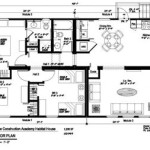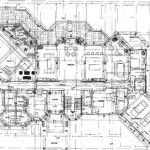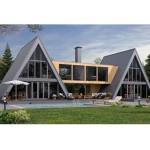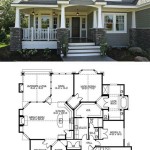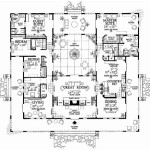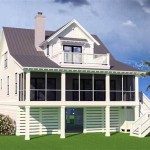1 Bedroom Floor Plan With Dimensions In Meters
Designing a functional and comfortable 1-bedroom apartment or house necessitates careful consideration of the floor plan. Maximizing space, ensuring adequate natural light, and creating a smooth flow are all critical aspects of successful design. This article explores various 1-bedroom floor plan layouts, focusing specifically on dimensions in meters, to provide a comprehensive understanding of how to effectively plan and utilize space in a compact living environment.
The dimensions of a 1-bedroom apartment typically range from 30 to 60 square meters, though this can vary widely depending on location, architectural style, and intended market. A well-designed floor plan within such parameters must prioritize functionality and comfort. Crucially, the layout should allow for distinct zones for living, cooking, sleeping, and bathing, even within a relatively small footprint. Understanding standard dimensions for each of these zones is paramount when evaluating or creating floor plans.
Key Considerations for a 1-Bedroom Floor Plan
Several factors should be considered to optimize space and functionality when designing a 1-bedroom floor plan. These include the orientation of the building, the placement of windows, the intended furniture arrangement, and the storage solutions integrated into the design.
Firstly, the orientation of the building with respect to the sun significantly impacts the natural light and heating of the apartment. A south-facing orientation typically provides the most consistent sunlight throughout the day, which is advantageous for living spaces. The design should, therefore, maximize the use of windows on the south-facing side, while minimizing their size or incorporating shading devices on the east and west to prevent overheating during summer months. Dimensions of windows will vary but ideally, large windows in the living room should be at least 1.5 meters wide and 1.2 meters high. Bedroom windows might be slightly smaller, around 1 meter wide and 1 meter high.
Secondly, the placement of windows directly influences the furniture arrangement. The floor plan should allow for ample space around windows to avoid obstructing natural light and ventilation. For instance, placing a sofa directly in front of a large window might block natural light and hinder the ventilation of the room. It is also important to consider pedestrian walkways. Walkways need to be considered when placing furniture. A good rule of thumb is to ensure walkways are at least 80 cm wide.
Thirdly, storage is a major consideration in small spaces. Incorporating built-in storage solutions, such as wardrobes, shelves, and under-bed storage, can significantly maximize usable space and reduce clutter. The dimensions of wardrobes should be carefully planned to accommodate the specific needs of the occupants. A standard wardrobe typically measures 60 cm in depth and 1.2 to 1.8 meters in width, with a height of around 2.4 meters. Built-in shelving can be designed to fit specific wall dimensions, optimizing vertical space and creating visually appealing storage solutions.
Analyzing Different 1-Bedroom Floor Plan Layouts
Several common 1-bedroom floor plan layouts exist, each with its own advantages and disadvantages. Understanding these layouts and their typical dimensions allows for informed decision-making when selecting or designing a 1-bedroom apartment.
One common layout features an open-plan living and kitchen area, with a separate bedroom and bathroom. In this layout, the living area typically measures between 4 meters by 5 meters (20 square meters) to 5 meters by 6 meters (30 square meters), providing ample space for seating, dining, and entertainment. The kitchen area is often integrated into the living space, with a kitchen island or peninsula serving as a visual divider and providing additional counter space. A standard kitchen island is typically 1 meter wide and 2 meters long. The bedroom in this layout typically measures between 3 meters by 3.5 meters (10.5 square meters) to 3.5 meters by 4 meters (14 square meters), providing sufficient space for a double bed, bedside tables, and a wardrobe. The bathroom typically measures between 1.5 meters by 2 meters (3 square meters) to 2 meters by 2.5 meters (5 square meters), accommodating a toilet, sink, and shower or bathtub.
Another layout involves a more defined separation between the living and kitchen areas, with a hallway leading to the bedroom and bathroom. In this layout, the living room might measure 3.5 meters by 4.5 meters (15.75 square meters), while the kitchen measures 2.5 meters by 3 meters (7.5 square meters). The hallway can range from 1 meter to 1.5 meters in width and depends on the size of the dwelling. The bedroom and bathroom dimensions remain similar to those in the open-plan layout. This layout is advantageous for those who prefer more privacy and separation between different areas of the apartment.
A third layout prioritizes space efficiency, with a compact living and kitchen area, a small bedroom, and a combined bathroom and laundry room. In such a layout, the living area might measure 3 meters by 4 meters (12 square meters), while the bedroom measures 2.5 meters by 3 meters (7.5 square meters). The bathroom and laundry room, combined, might measure 2 meters by 2.5 meters (5 square meters). This layout is ideal for individuals who prioritize affordability and minimal space requirements.
Optimizing Space with Detailed Dimensions and Examples
To illustrate the importance of detailed dimensions in optimizing space, consider several specific examples within a typical 1-bedroom floor plan.
Living Area: In a 4 meters by 5 meters living area, the placement of furniture is crucial. A sofa measuring 2 meters in length and 80 cm in depth can be placed against one wall, leaving ample space for a coffee table (1.2 meters by 60 cm) and a television console (1.5 meters by 40 cm) on the opposite wall. A rug measuring 2 meters by 3 meters can define the seating area, creating a visual anchor. The remaining space can be used for a dining table (80 cm by 120 cm) and chairs, positioned near the kitchen area. The area dedicated to walkways in the living area should be no less than 80cm to allow for ease of access to the kitchen, bedroom and bathroom.
Kitchen Area: In an open-plan kitchen, a counter running along one wall might measure 3 meters in length and 60 cm in depth. This provides sufficient space for a sink, stovetop, and food preparation area. Overhead cabinets, measuring 30 cm in depth and 60 cm in height, can be installed above the counter to maximize storage space. A refrigerator, measuring 60 cm by 60 cm, can be positioned at the end of the counter. A kitchen island, measuring 1 meter by 2 meters, can provide additional counter space and seating, while also serving as a visual barrier between the kitchen and living area. The distance between the counter and island should be over 1 meter to allow ease of access.
Bedroom: In a 3 meters by 3.5 meters bedroom, a double bed measuring 1.4 meters by 2 meters can be placed against one wall, leaving space for bedside tables (40 cm by 40 cm) on either side. A wardrobe, measuring 60 cm in depth and 1.5 meters in width, can be placed against another wall. A dressing table, measuring 80 cm by 40 cm, can be positioned near the window, providing natural light for grooming. A rug measuring 1.6 meters by 2.3 meters can define the sleeping area. The placement of furniture should allow for adequate walkways around the bed and into the wardrobe.
Bathroom: In a 1.5 meters by 2 meters bathroom, a toilet measuring 40 cm in width and 70 cm in depth can be positioned along one wall. A sink, measuring 50 cm in width and 40 cm in depth, can be placed next to the toilet. A shower stall, measuring 90 cm by 90 cm, can be positioned in the corner of the bathroom. Alternatively, a bathtub, measuring 70 cm in width and 150 cm in length, can be installed instead of a shower stall. The layout should ensure sufficient space for movement and access to each fixture.
By carefully considering these dimensions and layouts, one can effectively plan and optimize space in a 1-bedroom apartment or house, creating a comfortable and functional living environment.

Small House Plan 7x6 Meters 1 Bed Hip Roof Ground Floor

One Bedroom House Plans Peggy

One Bedroom House Plans 21 Feet 6 5 5m Gable Roof Design 3d

Best Small 1 Bedroom House Plans Floor With One

Cottage Style House Plan 3190 The Bunting

Small House 4x7 Meters With 1 Bedroom Loft Bed Shed Roof Samhouseplans

Simple Basic 1 Bedroom House Plans Under 1200 Sq Ft

30x26 House 1 Bedroom Bath 780 Sq Ft Floor Plan Instant Model 3b

One Bedroom Small House Plan 6x7 Meter 42 Sqm Samhouseplans

Country One Story House Plan With Open Concept And Fabulous Deck 1145
Related Posts



